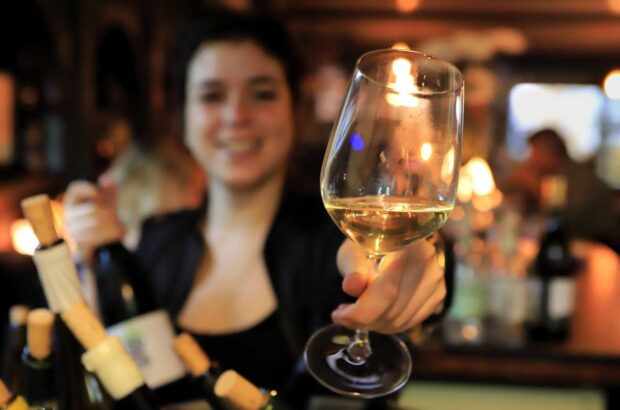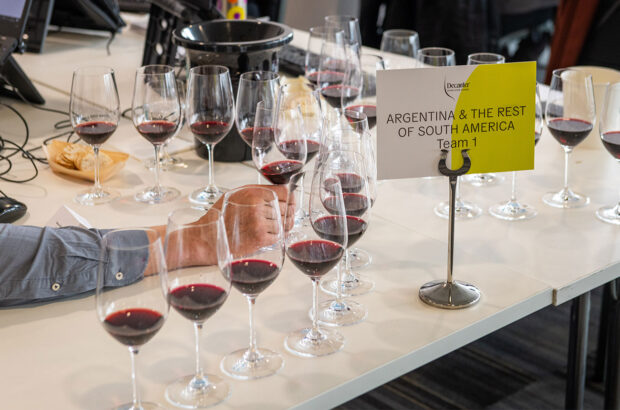Stephen Brook's Bordeaux 2009 Blog: Day 5 Stephen Brook's Bordeaux 2009 Blog: Day 4 Stephen Brook's Bordeaux 2009 Blog: Day 3 Stephen Brook's Bordeaux 2009 Blog: Day 2 Stephen Brook's Bordeaux 2009 Blog: Day 1 Drove past a spectacular double rainbow to Pauillac, where I tasted first growths Lafite and Mouton.
Drove past a spectacular double rainbow to Pauillac, where I tasted first growths Lafite and Mouton. Here the directors, Charles Chevalier and Philippe Dhalluin respectively, take a more subdued approach than their counterparts at Margaux or Latour, standing back while the tasting takes place, but ready to answer any questions. The Lafite seemed impenetrable, even more so than the Latour, very imposing and powerful but not easily recognisable as Lafite – but then it’s still a baby. Mouton had more flesh and sensuality, very much in the Mouton style, and the second wine Petit Mouton was sheer charm.
Cos d’Estournel is proving to be the wine that divides opinions this year. I quite liked it, but it is crafted in a bold, dense extracted style with little apparent finesse. It may well go the distance, or it may end up in a swamp of tannins. Then down to Margaux for the official tasting of St Julien, Paulliac, and St Estèphe. This, as so often, is the true heart of Bordeaux, with many glorious wines offering just the right balance of sensuality, fruitiness, acidity, and structure.
To lunch at Château Palmer, where the 2009 is all one could hope for. Peter Sisseck of Pingus confirmed that part of Phélan-Ségur had indeed been sold (as bruited in my musings some days ago). Over lunch I tried to pump the Palmer team about how the 2009s would sell. ‘We know we will sell the wine, but we do not necessarily know who will buy the wine,’ said Bernard De Laage. I think I could have worked that out for myself. Robert Whitley, an American journalist from San Diego, was fairly confident that Americans would re-enter the market, as this will be a collector’s vintage.
Technical director Thomas Duroux, formerly winemaker at Ornellaia, talked about non-Bordeaux wines being sold through the Bordeaux negociants, as already happens with Ornellaia’s all-Merlot Masseto. Peter Sisseck was clearly intrigued by the suggestion, and had already given it some thought, but with a production of only 5000 cases he thought it hardly worthwhile. Duroux asked me whether a wine such as Corton-Charlemagne from Bonneau de Martray wouldn’t benefit from the negociant treatment. How so, I wanted to know. ‘It would add value to the wine.’ To which I replied: ‘I think that’s a way of saying the market would drive up the price, thus making the wine unaffordable to its traditional loyal customers, who have always bought the wine from importers as a steep but fair price.’ As so often with the Bordeaux establishment, very little thought is given to the end consumer.
With a couple of tastings stops en route, I transported myself to the luxury of Château Malartic-Lagravière in Léognan. The Bonnie family, who bought the property in 1996, have done a superb job in transforming not the only once mediocre wine, but the property itself. They built a new winery and cellars, and, finding the chateau itself a tad small, simply built a replica next door and linked the two, thus creating a private space for the family on one side and a public space for visitors on the other. And if there is a kinder, less pretentious family in Bordeaux, I have yet to meet it.
Raising a social magnet in the air. they pulled in our very own Steven Spurrier, and a clutch of journalists from Austria, Hong Kong and Poland, and also invited the venerable but still impish André Lurton , who brought from La Louvière magnums of 1986, white as well as red, to set alongside the magnums of Malartic (1982 and 1964) provided by the Bonnies. None of the old red wines was a patch on the 1998 Malartic, which was quintessential Graves. The high point of the evening was waving everybody goodbye and running up the stairs to my room and hurling myself into bed while thinking of the others making their weary way back to their own chateau dormitories.
Tomorrow I will taste the Haut-Brion stable, and the top Pessac-Léognans, and then head for the final lunch before beginning my drive home. I will now bow out and leave my colleagues to report on these final wines. It has been a fantastic week. Never have the wines been so easy to taste, and the perception that a truly great vintage is in the making has been exhilarating. Combine the sheer hedonism of the 1982s and the structure of the 2005s, and you will have some idea of what is in store.
Written by






